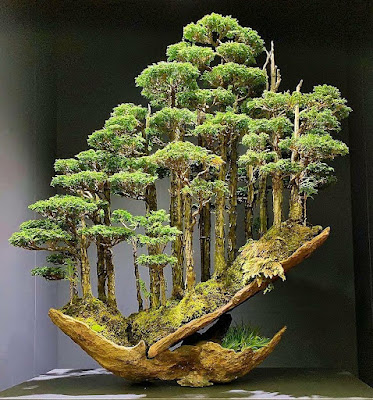Below is an excerpt from an article that appeared in the New Yorker, about an American who apprenticed himself to a Bonsai master in Japan for 6 years.
How hard could such an apprenticeship be? Well, brutal might be the way to describe it.
The full article may be read here.
In the winter of 2002, a young American named Ryan Neil joined an unusual pilgrimage: he and several others flew to Tokyo, to begin a tour of Japan’s finest collections of bonsai trees. He was nineteen, with an athlete’s body and a sunny, symmetrical face. The next-youngest adult in the group was fifty-seven. Then, as now, rearing tiny trees in ornamental pots was not commonly considered a young man’s hobby.
Neil had grown up in a small Colorado mountain town. For much of his youth, he was focussed on playing sports, especially basketball, which he approached with an almost clinical rigor: during high-school summer breaks, he’d wake up every day at five-thirty and attempt twelve hundred jump shots before going to the gym to lift weights. By his junior year, he was the best player on the team. By his senior year, he had torn one of his quadriceps—“It was hanging on by just a thread,” he recalls—and was looking for a new obsession.
Like many Americans of his generation, Neil had discovered bonsai through the “Karate Kid” films. He was especially fond of the third movie in the series, which features dreamy shots of characters rappelling down a cliff face to collect a miniature juniper. In the films, the wise karate instructor, Mr. Miyagi, practices the art of bonsai, and in Neil’s young mind it came to represent a romantic ideal: the pursuit of perfection through calm discipline. One day, after seeing bonsai for sale at a local fair, he rode his bike to the library, checked out every book on bonsai, and lugged them all home.
About a month later, he got his hands on a trade magazine, Bonsai Today, which featured an article about Masahiko Kimura, the so-called magician of bonsai, who is regarded by many enthusiasts as the field’s most innovative living figure. (Kunio Kobayashi, one of Kimura’s chief rivals at the time, called him “the kind of genius who comes along once every hundred years, or maybe more.”) The article described how Kimura had transformed and refined a small juniper tree that had been collected in the wild. A scruffy, shapeless plant had become a cantilevered sculpture. As Neil saw it, Kimura had given the tree not just a new shape but a soul.
Near the end of high school, Neil laid out a meticulous long-term plan that would culminate in his travelling across the Pacific to apprentice under Kimura, who was considered the toughest bonsai master in Japan. Neil knew that the work would not be easy. Bonsai apprenticeships could last anywhere between five and ten years. At the time, some fifty people had begun working under Kimura, but only five had completed the apprenticeship, all of them Japanese.
Neil went to college at California Polytechnic State University, in San Luis Obispo, where he majored in horticulture and studied Japanese. He helped take care of the university’s bonsai collection and travelled around the West Coast to attend master classes with renowned practitioners. While other students were partying, he stayed home looking at bonsai blogs, or drove his pickup truck to remote mountain locations in search of wild miniature trees. “He was possessed,” his father recalls.
Neil signed up for the tour of Japan during his sophomore year, and took a short leave from school. On the second day of the trip, the group visited Kimura’s garden, in a rural area some thirty miles northwest of Tokyo. It was a cool, gray morning; Neil wore a hoodie. The group was met by one of Kimura’s apprentices and ushered past rows of ancient and pristinely shaped bonsai into the back garden—the workshop—where few visitors were allowed.
Neil later likened the moment to peering into the mind of a mad genius. Hundreds of knee-high trees, in various states of arboreal surgery, were lined up on benches and beer crates. Custom-made power tools were scattered around the workshop, including a machine, used to sculpt trunks, that shot out tiny glass beads. Kimura was famed for his deft use of these devices to carve rippling torrents of shari—bone-white deadwood that is laced with thin veins of living wood.
That day, Kimura, who was then in his sixties, was working on an Ezo spruce with a spiky, half-dead trunk which was estimated to be a thousand years old. A photographer from the Japanese magazine Kindai Bonsai was present to document the process. Neil and the other visitors observed as Kimura, with the help of his lead apprentice, Taiga Urushibata, used guy wires and a piece of rebar to bend the trunk downward, compressing the tree—an act requiring a phenomenal balance of strength and finesse. Kimura misted the branches with water and wrapped them with thick copper wire. He then bent the branches—some slightly upward, some downward—arranging the foliage into an imperfect dome, with small windows of light spaced throughout the greenery. He worked with relentless focus, but what amazed Neil most was the synchronicity of Kimura and Urushibata: whenever Kimura needed a tool, he would wordlessly extend his hand, and Urushibata would have the implement waiting for him.
After Kimura had made his design decisions, he left Urushibata to finish wiring the branches. The tour group moved to the front garden, but Neil lingered, watching the apprentice work. Urushibata, a stern young man with the pretty face and floppy hair of a J-pop idol, turned to Neil and spoke to him, in English.
“So you want to apprentice here?” Urushibata said.
“I do,” Neil said.
“You should reconsider,” Urushibata said, then turned his attention back to the spruce.

No comments:
Post a Comment